Elastic Buckling Loads of I-Section Steel Columns with a Variety of Web Hole Shapes
Ngoc Hieu Pham*
Faculty of Civil Engineering, Hanoi Architectural University, Vietnam
Submission: February 20, 2023; Published: May 20, 2023
*Corresponding Author: Ngoc Hieu Pham, Faculty of Civil Engineering, Hanoi Architectural University, Vietnam
How to cite this article: Ngoc Hieu Pham. Elastic Buckling Loads of I-Section Steel Columns with a Variety of Web Hole Shapes. Civil Eng Res J. 2023; 13(5): 555872. DOI 10.19080/CERJ.2023.13.555872
Abstract
The paper presents the behaviour and the elastic buckling loads of I-section steel columns with various web hole shapes. The behaviour of such steel columns is analysed according to two direction axes including the actual axis (y-y) and the virtual axis (x-x). Based on the behaviour of the I-section steel columns in two axes, the elastic buckling loads are formulated. It is found that the elastic buckling loads of the I-section columns with perforations in the virtual axis are determined with the consideration of shear action effects. Also, the elastic buckling loads of such columns depend on the shapes and dimensions of the web holes as well as the distances between these holes.
Keywords: Elastic buckling loads; I-section steel columns; Web hope shapes
Introduction
Steel members with perforations have been widely used in structural buildings to adapt the technical system requirements, material savings and aesthetic aspects. This steel member type can be seen in many buildings such as Home Place Club or Liverpool Porche illustrated in Figure 1. The appearance of these web holes is convenient to arrange the technical systems such as electricity, water or fire pipes. In terms of economic aspects, this solution allows for reducing the material cost due to the decline of structures’ self-weight. Also, the height of section members is found to significantly increase, this helps to rapidly increase member rigidity compared to this of the solid member with the same material expenditure. For architectural requirements, this solution allows structural members to become aesthetic with their own architectural style.
In terms of manufacturing, these perforated steel members can be made by dividing I-sections into two pieces as shown in Figure 2.These two pieces, subsequently, are combined together usingwelding; this allows the sectional heights of the new members toincrease from 1.4 to 1.5 times in comparison with those of original section members. There are also a variety of web hole shapes that can be made to satisfy the usage requirements as shown in Figure 3.
There were a large number of research studies on steel structural members with holes. The effects of various hole shapes on the strengths of stub columns as presented in publications [1-4]. The hole locations and hole lengths were also considered in many previous studies [5-8]. These studies focused on experimental and numerical investigations to investigate the strengths and behaviours of steel members with perforations. The determination of elastic buckling loads of steel members with holes was determined by various methods such as experimental or numerical analyses. In terms of theoretical methods, studies on elastic buckling loads of steel members with perforations remain scarce. The paper, therefore, is aimed to propose a set of formulae to calculate the elastic buckling loads of I-section steel columns with a variety of web hole shapes.
The strength and behaviour of I-section steel columns with perforations
It was found that shear deformations have negligible impacts on the capacities of solid columns, but this has noticeable impacts on the strengths and behaviours of steel columns with perforations [9]. The shear deformations, therefore, are considered in this study to investigate the elastic buckling loads of this type of steel column. The I-section steel columns with perforations can be assumed as open-web steel columns including two tee branches as shown in Figure 4. Hence, the buckling behaviour of I-section steel columns are analysed in two directions including the actual axis (y-y) and virtual axis (x-x). Two types of web holes are considered in this paper consisting of circular and hexagon hole shapes (see Figure 4).
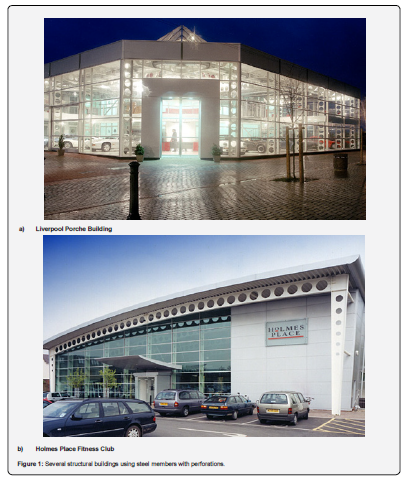
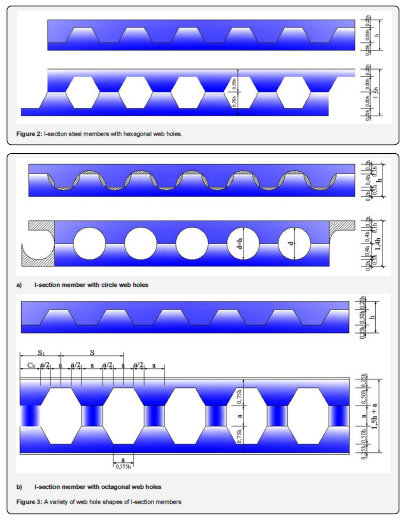

The behaviour of I-section steel columns with perforations about the virtual axis (x-x)perforations about the actual axis (y-y)
If buckling occurred, two tee section branches were bent around the actual axis (y-y). It was found that the connected webs between two branches were not resisted any moments or deformations. These connected webs, therefore, were ignored in the working of this type of column in the actual axis; and, the behaviour of I-section steel columns with perforations can be considered to work as the behavior of two tee solid columns about the actual axes (y-y).
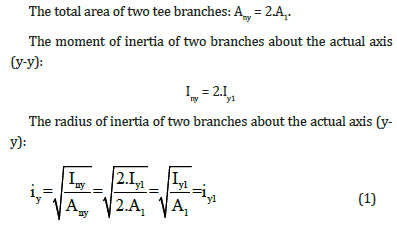
The slenderness of I-section steel columns about the actual axis (y-y):
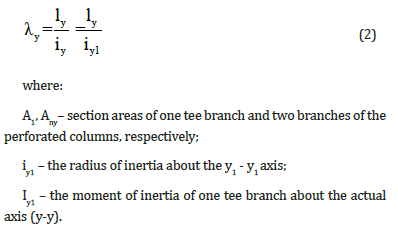
The behaviour of I-section steel columns with perforations about the virtual axis (x-x)
In the virtual axis (x-x), the I-section steel columns not only resisted stresses due to moments but also shear actions. These shear actions led to the distortions of two tee branches as illustrated in Figure 5. The deformations due to the effects of shear actions had significant impacts on the stability of I-section steel columns with web holes, leading to the reductions of the elastic buckling loads of this type of column (Ncr). The elastic buckling loads about the virtual axis (x-x), therefore, were determined with the consideration of shear action impacts as following Eq. (3) as presented in [9]:
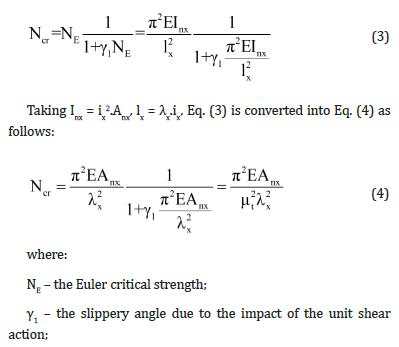
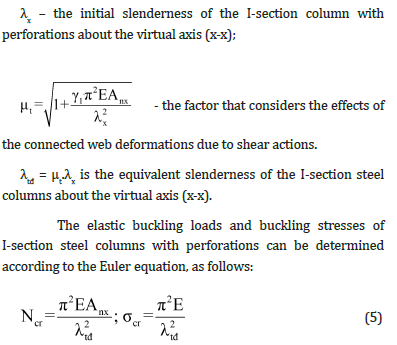
Hence, it is necessary to determine the equivalent slenderness of the I-section steel columns about the virtual axis (x-x) in order to calculate the elastic buckling loads of this type of column.
Determination of the equivalent slenderness λtđ of cellular columns with virtual axis x-x
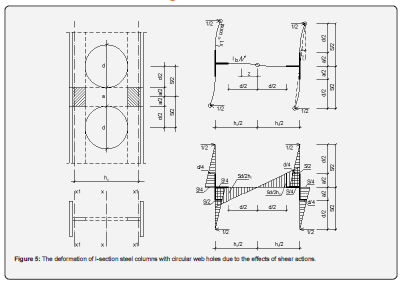
To simplify the procedure in the determination of internal forces and local deformations of I-section steel columns due to the effects of shear actions, the mid-points at the two tee branches between two holes and the mid-points at connected webs having zero moment force were considered as hinges [9]. Intersections between the two tee flanges and the connected webs were considered as highly rigid areas in the analysis (see Figure 5) [10]. The equivalent slendernesses can be determined for two web hope shapes including circular and hexagon web holes.
In terms of I-section steel columns with circular web holes, the highly rigid area was considered as shown in Figure 5. The slippery angle γ1 is made due to the unit shear force (V=1) determined according to the following calculations.
The lateral deformation was determined according to the Veresaghin principles [11] as follows:

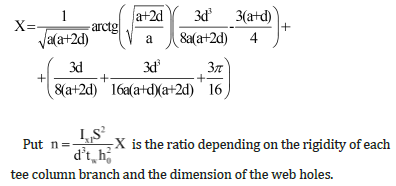
For I-section steel columns with hexagon web holes, the highly rigid areas were illustrated in Figure 6. The slippery angle γ1 is made due to the unit shear force (V=1) determined according to the following calculations.
The lateral deformation was determined according to the Veresaghin principles [11] as follows:
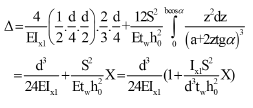
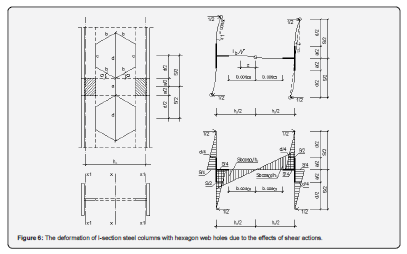
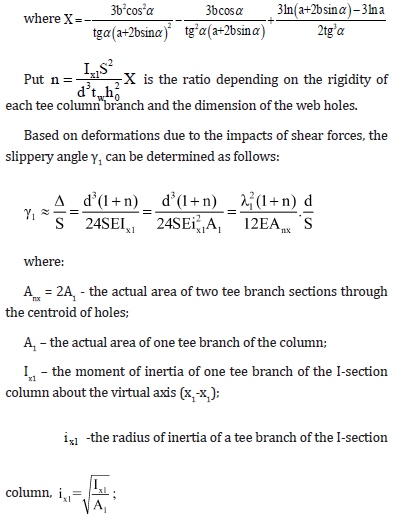
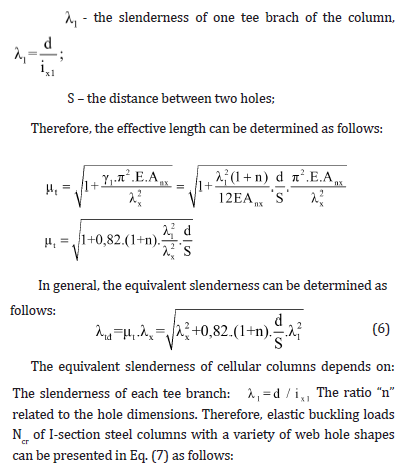

It was found that the elastic buckling loads of I-section steel columns with perforations can be calculated on the basis of the dimensions and the shapes of web holes, and the distances between holes.
Conclusion
The paper presents the behaviors of I-section steel columns with perforations according to two axes including the actual axis (y-y) and the virtual axis (x-x). It was found that the behaviour of the I-section steel columns about the actual axis can be considered as a separate working of two tee solid columns whereas these two branches were connected to work together due to the connected webs. Several remarks are given as follows: 1) The effects of shear actions should be accounted for in the determination of elastic buckling loads of I-section steel columns with perforations about the virtual axis; 2) The values of elastic buckling loads depended on the hole dimensions, hole shapes and distance between holes.
References
- Ortiz-Colberg RA (1981) The load carrying capacity of perforated cold-formed steel columns,” Ph.D. thesis, Cornell University, Ithaca, NewYork, USA.
- Sivakumanran KS (1987) Load capacity of uniformly compressed cold-formed steel section with punched web. Can J Civil Eng 14(4): 8.
- Banwait AS (1987) Axial load behaviour of thin-walled steel sections with openings. Master dissertation, Hamilton, Ontario.
- Abdel-Rahman N (1997) Cold-formed steel compression members with perforations. Master dissertation, Hamilton, Ontario
- Rhodes J, Schneider FD (1994) The compressional behaviour of perforated elements,” in Twelfth international specialty conference on cold-formed steel structures, pp. 11-28.
- Loov R (1984) Local buckling capacity of C-shaped cold-formed steel sections with punched webs. Can J Civil Eng 11(1): 1-7.
- Pu Y, Godley MHR, Beale RG, Lau HH (1999) Prediction of ultimate capacity of perforated lipped channels. Journal of Structural Engineering 125(5): 4.
- Rhodes J, Macdonald M (1996) The effects of perforation length on the behaviour of perforated elements in compression,” in Thirteenth international specialty conference on cold-formed steel structures, pp. 91-101.
- Pham VH, Nguyen QV, Pham VT, Luu VT (2009) Steel Structure - Elements. Science and Technology Publication, Hanoi, Vietnam.
- Vu QA (2010) Analysing the working of the steel frame which consider the rigid areas of connection. Workshop about Construction under Exceptional Conditions, Hanoi, Vietnam.
- Leu TT (2006) The stability of buildings. Science and Technology Publication, Hanoi, Vietnam, pp. 80-84.






























